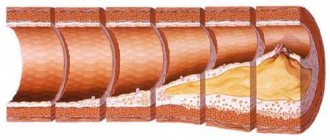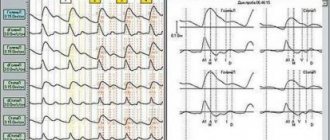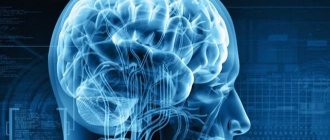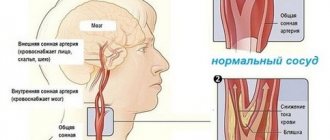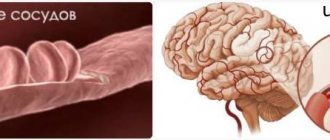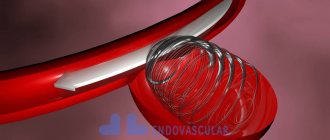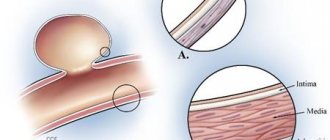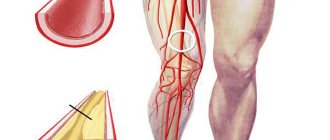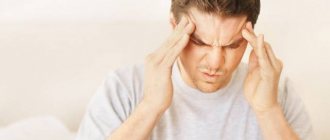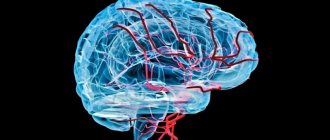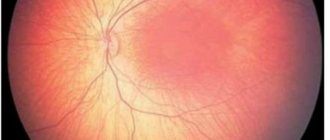What happens during vasospasm of the head
Vasospasm is a sudden narrowing of the lumen of blood vessels in the brain.
When it occurs, the patient’s well-being rarely worsens. Due to oxygen starvation of brain cells, various disorders of the central nervous system develop. Vascular spasms in the head are a dangerous condition that can cause the development of serious diseases. The occurrence of spasm is associated not only with problems of the brain, but also of the cervical spine. After all, it is through it that the arteries supplying the brain with blood pass. Prolonged hard work affects the quality of blood supply to the brain, which can cause a deterioration in the general condition of blood vessels.
The brain is an organ that regulates the functioning of all processes and systems in the body. To perform its functions efficiently, it needs adequate nutrition, which is provided through blood vessels.
The movement of blood through the vessels occurs when their walls contract and relax. Vessel spasm consists of contraction of its walls, which is not followed by relaxation. As a result, blood circulation becomes difficult and a characteristic pain syndrome also occurs.
Causes of vascular stenosis
Stenosis of the cerebral arteries does not occur spontaneously; the pathology is always preceded by concomitant diseases and, as a rule, in a chronic form.
Among the main diseases that provoke stenosis, there are various vascular pathologies and degenerative changes in the musculoskeletal system:
- Atherosclerotic damage to blood vessels - with high cholesterol in the blood, salts begin to accumulate on the walls or in the thickness of the vessel, which gradually layer and thicken. Thus, a cholesterol plaque is formed, which leads to structural disorders and micro-tears. Cholesterol compaction narrows the lumen inside the artery and affects hemodynamics;
- Hypertension - normally the muscular layer of blood vessels is in good shape, but with atherosclerotic changes or the influence of other negative factors, a compensatory mechanism is triggered. Signals are sent from the brain to restore blood flow, and since stenosis as a result of plaque growth is dangerous due to rupture of the vessel, a forced increase in tone occurs. The internal lining of the artery becomes denser, but this leads to a loss of elasticity and, as a result, the brain tissue begins to receive even less nutrients and oxygen (weak cerebral nutrition);
- Osteochondrosis – degenerative changes lead to deformation of all structures of the spine. Compression of the vertebral arteries in the cervical spine provokes mechanical stenosis, thus the brain does not receive enough blood to maintain its functionality.
In addition to concomitant pathologies, there are also risk factors that influence the occurrence of structural changes in the vascular bed:
- Bad habits (alcohol, tobacco);
- Unbalanced diet (frequent diets) or consumption of large amounts of fat;
- Frequent stress;
- Excessive consumption of caffeinated drinks;
- Hormonal surge in the juvenile period;
- Hereditary pathologies.
Structural changes in blood vessels inevitably occur after the decline of reproductive function, both in women and men.
How to change your diet?
Since the initial phases of atherosclerosis of the cerebral arteries cause vasospasm, treatment should begin with a preventive diet and balanced nutrition, without waiting for symptoms of severe vascular pathology.
The diet must be followed, avoiding long breaks and overeating. Fast food, sweet soda and dry food are strictly prohibited.
The volume of clean (preferably filtered) water drunk should approach 2 liters daily. Coffee is limited to two cups per day. Green tea is healthier.
Healthy food will relieve not only vasospasm, but also many other problems
It is recommended to avoid dishes made from fatty meats, lard, and smoked meats. Hot sauces, mayonnaise, ketchup, adjika are contraindicated. It is worth limiting the consumption of salted and pickled vegetables.
You should avoid confectionery, fresh baked goods, and sweets.
The daily menu should include:
- porridges made from unpolished cereals (cereals and ready-made breakfasts lose their benefits when processed);
- meat dishes from chicken, turkey, lean meat;
- sea fish;
- whole vegetables and fruits, in salads, fresh juices, high-quality dried fruits;
- seaweed;
- vegetable oil (linseed, olive, sunflower);
- low-fat dairy products;
- any greens (lettuce, onion, parsley, dill).
Instead of sugar, try to eat honey and berries (currants, cranberries).
Treatment of brain tumors with folk remedies
If a patient has been diagnosed with a brain cyst, treatment with folk remedies can have a positive effect on the general condition of the patient. For a cyst that does not tend to progress, you can use herbs that reduce intracranial pressure, such as:
- black elderberry;
- horsetail.
Horsetail
Initial letter
Black elderberry
Celery
Feverweed
Asparagus
Herbs can be used individually, but the best effect is achieved if you make herbal infusions from them. Brew with boiling water, insist and take every day for several months.
Treatment with Hemlock
Herbal collection
It is also necessary to use a herbal mixture, which we will discuss below. It has a less pronounced effect than hemlock but contains many substances useful to the body that have a positive effect on the healing process. It is necessary to mix in equal proportions:
- Chicory herbs;
- Violet;
- Sowing season;
- Longifolia herbs;
- Calendula;
- Calamus marsh;
- Corn silk;
- Licorice;
- Yarrow;
- Alternately.
A total of equal proportions of these herbs should be mixed in a volume of 2 tablespoons and brewed with 0.5 liters of boiling water. Leave to infuse for 8 hours. Then strain and take half a glass up to five times a day.
Bolotov's medicinal kvass for brain cysts
The author of this recipe is the famous physicist-biologist and scientist Boris Bolotov. Beets have the ability to normalize metabolic processes, improve general condition, normalize blood pressure and prevent the occurrence of tumors.
To prepare, you need to: peel the beets, chop them finely and place them in a three-liter jar. The beets should occupy two-thirds of the container. A spoonful of low-fat sour cream must be dissolved in cooled boiled water and the resulting liquid must be poured into a jar of beets. There is no need to fill the container completely. There should be 3 centimeters left from the neck of the jar. Periodically, as it forms, it is necessary to remove the mold that forms. The liquid will need to be poured into another container when sediment appears in the jar. Then you need to add warm water and after 10 days consume 100 ml 2-3 times a day.
Types of vascular spasm
Types of brain spasms are divided according to severity:
- Mild form (angiospasm). All symptoms of the disease are mild, so the patient’s condition will quickly recover. Most often, no treatment is even required.
- Angiodystrophic. The spasm causes general weakness and pain. The walls of the vessels reach the stage of degeneration. Requires immediate treatment.
- Cerebro-necrotic spasm. In this case, loss of consciousness, impaired movement, speech and vision, severe headache, and vomiting occurs. In some cases, it causes cyst formation. Requires immediate hospitalization.
Types of spasms can also be divided according to the distribution of damage:
- Local. The presence of damage only in a specific area.
- Are common. The damage is more extensive. It is observed in hypertension, increased blood viscosity and circulatory disorders in the brain.
The importance of the regimen in treatment
It is always difficult to be treated with medications alone. They must be taken under certain conditions, the correct dosage, and carried with you to work. At the same time, you should clearly understand that the best pills will not help if you continue to sleep in fits and starts, smoke, and experience nervous overload every day, which is “relieved” by alcohol.
Every person who cares about their health has a negative attitude towards bad habits and relies not on medications, but on their own willpower.
Help improve your sleep:
- daily walks in any weather outdoors;
- control over the ventilation of home and work areas;
- herbal teas in the evening with lemon balm, mint and honey.
In work mode, you need to provide short breaks of 10–15 minutes with a short physical warm-up.
You should relax through exercise, yoga, self-massage, warm showers or sea salt baths. You can try psychological trainings by G.N. Sytin, a famous psychotherapist. He calls them “moods,” precisely formulated orders to himself. You can select the desired “mood” and listen to it while simultaneously viewing pictures on the Internet. It will take no more than 20 minutes a day. The action implies assistance in mastering the auto-training technique.
Children can be taught to relax from kindergarten
Strength training is not recommended for frequent headaches. You can ride a bike, go to the pool.
It is necessary to add elements of art to your vacation (listening to classical music, attending concerts, exhibitions, the theater).
First signs
The main symptoms of vascular spasm and circulatory disorders in the brain area:
- headache, which can be localized in a specific area or can cover the entire head;
- dizziness, spots before the eyes;
- tinnitus that becomes louder with sudden movements or physical activity;
- lack of coordination;
- nausea and vomiting.
Headaches can be felt almost anywhere on the head. It can be caused by variable weather, stress or fatigue. As a rule, the pressure in this case is increased or decreased.
Symptoms of the disease
General signs of diseases of the circulatory system of the brain:
- Strong headache;
- Dizziness, sometimes with nausea;
- Insomnia, apathy and fatigue;
- Hot flashes or chills;
- Numbness of a body part;
- Attention disorder;
- Hyper- or hypotension;
- Fainting;
- Impaired coordination of movements;
- Tachycardia.
Many people mistakenly believe that only hypertension is a cause for concern. But this is not true: low blood pressure is also not the norm, as it can cause serious consequences. It is provoked by dilation of blood vessels, which leads to slower blood flow and insufficient blood supply to brain structures.
Hypotension for the functioning of the central nervous system is dangerous because neurons stop receiving enough nutrients. Subsequently, they weaken and cannot work properly. On the other hand, a decrease in blood flow in the veins leads to stagnation of metabolic products in the nervous tissue.
This causes chronic intoxication of the brain - poisoning and accumulation of harmful substances. Together with hypoxia, these processes threaten degeneration and necrosis of functional cells of the central nervous system, heart and other vital organs.
Chronic hypotension provokes weakening of the walls of blood vessels. This can lead to the development of edema, as blood begins to leak through them into the surrounding tissue and accumulate in it.
Weakening of the walls provokes the appearance of aneurysms - sac-like protrusions of arteries. Blood accumulates and stagnates in these cavities. An increase in the size of the aneurysm provokes its expansion to a critical state, and this can result in rupture and brain bleeding. The presence of an aneurysm is indicated by a general deterioration in the patient’s condition, attacks of dizziness, and nausea.
Diseases of the blood vessels of the brain provoke problems with other organs of the human body. A striking example of this is cardiovascular diseases: heart attack, angina, tachycardia. Their appearance is promoted by chronic hypertension.
This condition also leads to thickening of the blood and the formation of blood clots - thrombi. They can block the blood flow and cause a rupture of the wall, which will lead to hemorrhage. The cause of an acute condition - a stroke - is the blockage of blood flow by a thrombus and subsequent intracerebral bleeding.
Symptoms of cerebral vasoconstriction in the vast majority of cases are characterized by a gradual onset, but sometimes occur suddenly. The consequences in such a case can be the most dire. Due to a sharply narrowed passage in the artery, a person may experience a stroke, which can lead to loss of mobility and even death. Chronic stenosis of the head and neck vessels develops over several years; its first signs are invisible.
Drugs that treat cerebral vessels are used in the presence of the following symptoms:
- Regular headaches that affect the temples, forehead and back of the head.
- Sudden jumps in blood pressure.
- Frequent dizziness.
- Fatigue, critical decrease in performance.
- Noises in the ears.
- Memory impairment, deterioration in spatial orientation.
Treatment with medications
In the treatment of vasospasm in the brain, drugs with multidirectional effects are used:
- painkillers;
- relieving spasms (antispasmodics);
- preventing negative consequences in brain cells from temporary circulatory disorders;
- strengthening vascular tone;
- calming.
Tablets containing Paracetamol, Analgin (Mig, Pentalgin forte, Efferalgan Upsa) help to quickly relieve a painful headache. You need to know that their effect is limited to two to three hours. Having relieved pain, these drugs do not solve problems and do not eliminate the cause of the pathology, so they can only be used as symptomatic remedies.
The group of antispasmodics is represented by:
- Drotaverine forte,
- No-shpa,
- Papaverine,
- Belalgin,
- Spasmolitin.
These medications are derivatives of belladonna (Atropine) or have the properties of acting on the muscle wall of a vessel to relieve spasm.
The combined drug Andipal combines pain relief and the elimination of spasms, since it includes Analgin, Dibazol and Papaverine in working dosages.
The following have vasodilating properties: Atromidine, Eufillin, Mefacor, Atomax.
For long-term course treatment, agents are recommended that strengthen arterial walls and restore tone (Vinpocetine, Nicotinic acid, Cavinton).
Cavinton is a drug based on periwinkle that works well against spasm of the cerebral arteries
Nicotinic acid derivatives can be used for course treatment of vasospasm. Such products are used both in injection form and in tablet form. They help dilate small blood capillaries, thereby increasing blood flow to each individual cell and eliminating the symptoms of vasospasm.
Derivatives of the alkaloid of the common periwinkle plant have a beneficial effect on cerebral circulation. Once in the body, this substance acts as a natural antispasmodic, eliminating all the painful symptoms of vasospasm and preventing its consequences. In addition, vinca alkaloids (vinpocetine) help improve the metabolism of nervous tissue, prevent blood clots and increase the activity of cerebral blood flow.
Main representatives:
- Vinpocetine,
- Cavinton,
- Vincetin,
- Bravinton,
- Telektol.
Calcium antagonists normalize cerebral vascular tone (Diltiazem, Isoptin, Cordafen). Almost all medications from this group help expand the lumen of the arteries and do not affect the condition of the veins. Under such conditions, blood flow in the brain tissue increases, and nerve cells receive large portions of oxygen. Drugs from this group are widely used in medicine and today the 3rd generation of such drugs is being developed.
In addition to eliminating spasm of cerebral vessels, they are used to treat hypertension. Therefore, calcium antagonists are the drugs of choice for patients with hypertension and cerebral vasospasm.
3 groups of calcium antagonists:
- Phenylalkylamine derivatives – Verapamil.
- Dihydropyridine derivatives - Nifedipine, Amlodipine, Felodipine, Nicardipine, Nimodipine, etc.
- Benzothiazepine derivatives – Diltiazem.
Each of these medicinal substances must be prescribed strictly according to the doctor’s indications, as it has its own contraindications and side effects. To eliminate spasms of blood vessels in the head and neck, agents from the second group are used. They are the most effective for these purposes and safe for long-term use.
It is important to know! According to the latest clinical studies and the opinion of the most famous experts in the field of neurology, Nimodipine is considered the drug of choice for eliminating vascular spasms of the brain.
Motherwort forte, Novopassit, Corvalol, Valerian have a calming effect. These products from herbal sources are not addictive and are well tolerated by patients. If there is no effect, the neurologist prescribes stronger synthetic drugs.
To restore the effects of vasospasm and ensure the active functioning of brain cells, Nootropil, Glycine forte, Piracetam, Cortexin are recommended. They are taken in courses of treatment of 2–3 months.
Preparations based on gingko biloba have a complex effect on cerebral blood flow. They eliminate spasm of the cervical and cerebral vessels, change the rheological properties of the blood (promote its thinning), improve microcirculation, and strengthen the walls of arteries and veins. They also have powerful antioxidant abilities, improve the functioning of nerve cells in the brain, and have anti-edematous abilities.
You can also read: Tablets for brain vessels
Representatives:
- Bilobil,
- Gingium,
- Ginkor Fort,
- Biloba,
- Tanakan.
Drugs from this group are over-the-counter. They can be taken independently and without a doctor's prescription. But before that, it is better to read the instructions for use in detail, study all contraindications and possible side effects.
As prescribed by a doctor, anticoagulants (Warfarin, Sinkumar, Brillinta, Pradaxa) and antiplatelet agents (acetylsalicylic acid) are indicated to prevent thrombosis.
Patients with signs of cerebral atherosclerosis in the complex treatment of vasospasms must be prescribed drugs to lower blood cholesterol (Atorvastatin, Rosuvastatin, Simvastatin, Lovastatin).
Risk factors and pathophysiology
Symptoms of vasoconstriction are often expressed in the form of difficulties with remembering information, sudden mood changes for no particular reason, and unsteady gait. To understand how to treat disease-prone arteries, you need to become familiar with the factors underlying the pathology.
Atherosclerosis occurs due to the fact that cholesterol plaques accumulate on the inner surface of the brain (and not only) arteries, resulting in a narrowing of the blood vessels in the head. Blood flows more slowly through narrow arteries and veins.
When the vessels of the head and neck are narrowed, the brain begins to experience more and more severe oxygen starvation, which is accompanied by a disruption of many of its functions. Moreover, the resulting plaques can completely clog the passages in the arteries. This is a very dangerous phenomenon that leads to a variety of health problems.
Development mechanism
Reasons that provoke spasm of blood vessels in the head:
- Lack of sleep. The brain needs proper rest. Insufficient quantity or poor quality of sleep can cause vasospasm.
- Overwork. Vascular spasm can also occur as a result of overwork. If a person works a lot, the blood supply to the brain decreases. First of all, this concerns sedentary mental work. People who engage in physical labor suffer less often from vasospasm.
- Oxygen deficiency. Working in a poorly ventilated area and living in regions with poor ecology worsens brain nutrition. Therefore, it is recommended to spend more time outside and install an air purifier and humidifier in the room where you spend a lot of time.
- Smoking. In a smoker, the risk of developing the disease increases many times over. Moreover, just a few weeks after giving up the bad habit, this indicator returns to normal.
Vascular spasm can also be triggered by various situations, for example, drinking excessive amounts of alcohol, a stressful situation, or hypothermia of the head.
A spasm can also be triggered by a strong emotional situation, and the emotions do not have to be negative. Therefore, it is recommended to always remain calm, not worry or worry about trifles.
The basis of cerebral vascular spasm is a violation of neurohumoral regulation. Imbalance of mediators and dysfunction of calcium channels negatively affect the autonomic nervous system, which regulates vascular tone. During an attack, arteries and smaller cerebral vessels contract, and accordingly, blood flow slows down and the brain experiences oxygen starvation. As a result, characteristic symptoms appear, which can be reversible or irreversible.
In the first case, the spasm passes without consequences, in the second it is fraught with strokes, encephalopathy, and aneurysm rupture (especially in the presence of blood clots and atherosclerotic plaques).
Prolonged vasospasm during pregnancy can lead to eclampsia, a severe form of gestosis.
The causes of cerebral vasospasm include the following:
- Overwork. When a person works too much while sitting at a computer, for example, the blood supply to the brain deteriorates and vasospasm occurs.
- Lack of sleep. The brain, like any other organ of the body, needs to rest. His fatigue due to lack of sleep is expressed, among other symptoms such as headache, also in the onset of vasospasm.
- Lack of oxygen. The nutrition of the brain deteriorates, to which the blood vessels react first. You need to spend more time in the fresh air and ventilate the room in which you spend most of your time.
- Smoking. In a person who smokes more than a pack of cigarettes per day, the likelihood of vascular spasms in the head increases many times over compared to a non-smoker.
- Various diseases and conditions:
- Vegetative-vascular dystonia (accompanied by noise and ringing in the ears, shortness of breath, a feeling of weakness in the heart, coldness in the extremities);
- Cardiac dysfunction (shortness of breath, tachycardia):
- Disorders of the thyroid gland;
- Renal dysfunction;
- A brain tumor;
- Osteochondrosis of the cervical spine (narrowing of the openings in the processes of the vertebrae through which arteries pass that supply blood to the brain).
In addition, the most ordinary everyday situations can provoke a spasm in the head, for example, when a person is in the cold for a long time with his head uncovered, if he has drunk more alcohol than he can afford; if you experienced short-term stress (for example, you had an argument with someone at home or at work).
Any strong emotion can cause a spasm - not only negative, but also positive. Indian yogis recommend generally abstaining from strong emotions, since they “shatter” all systems of the body. And the brain is no exception. So, if you want to avoid spasm of cerebral vessels, which is fraught with such a terrible disease as a stroke, try not to worry, especially over trifles.
Prevention
Following some rules of vascular prevention can help reduce the likelihood of narrowing of cerebral vessels:
- Consume as little animal fat as possible, replacing them with seafood and plant-based proteins.
- Temper yourself, take a contrast shower from time to time.
- Spend enough time in the air, move more, provide the body with sufficient physical activity.
- Monitor blood pressure levels.
- Give up bad habits, first of all, smoking.
By following these simple recommendations, it is quite possible to maintain the health of your blood vessels into old age.
Treatment with physiotherapeutic methods
Physiotherapeutic methods should cause persistent relaxation of brain vessels, improvement of blood supply and restoration in tissues. Electrophoresis is used with various medications (Novocaine, Eufillin, Platyfillin, magnesium, potassium salts, iodine, bromine):
- on the collar area;
- with the location of electrodes on the eyeballs and the back of the head;
- intranasal electrophoresis;
- through impact on areas of the spine;
- by introducing the active substance in the area of the cervical sympathetic nodes.
In hydropathic conditions, carbon dioxide, radon and carbon disulfide baths, circular and fan showers are used.
Administration of the drug by endonasal electrophoresis enhances the effectiveness and brings it as close as possible to the brain vessels
A course of procedures helps improve sleep, relieve increased excitability and headaches.
Manifestations and clinical picture of the disorder
General symptoms depend on the location of the spasm and the size of the vessel. The main symptom is headache. In some cases, pain in one area gradually spreads to a larger area.
This may cause a feeling of tightness and heaviness in the head.
There are also additional symptoms that indicate cerebral vasospasm:
- pain in the eyes or neck;
- dizziness and increased pain when lying on your stomach;
- increased pain in the head when coughing;
- noise in ears;
- nausea and vomiting;
- pale face;
- increase or decrease in pressure;
- increased fatigue;
- sweating;
- numbness of the lips or temples.
If vasospasm precedes a stroke or ruptured aneurysm, symptoms may also include speech and hearing impairment, loss of consciousness, and paralysis of the limbs or one side of the face.
Traditional methods for convulsive contraction of cerebral vessels
Therapeutic actions of traditional medicine aimed at combating this pathology will be effective only in the case of vascular dystonia at the initial stage of the disease. Herbal infusions relieve unpleasant symptoms and improve the patient’s well-being. Traditional methods in most cases focus on the source of pathological processes. For example:
Need to exclude:
You should also stop drinking black tea.
and
coffee
.
Minimize the consumption of salt
and
spices
.
The diet must include:
It is advisable to add a spoonful of honey to your tea. You need to give up sugar forever. When you really want something sweet, you can replace it with berries: black currants, black rowan, strawberries or cranberries. These gifts of nature have a beneficial effect on the circulatory system.
Do not forget to consume a lot of clean water, it cleanses the body of harmful substances and medications.
Cerebral vasospasm
(so-called cerebrospasm) is an abnormal reflex narrowing of the lumen of blood vessels. The insidiousness of this condition is that it rarely exists on its own - very often cerebrospasm is a concomitant symptom of various systemic diseases, and also precedes the development of serious pathologies that are dangerous to the health and life of the patient, for example, stroke.
Long-term narrowing of the lumen of blood vessels leads to disruption of nutrition of all brain tissues or individual parts of it. When blood supply deteriorates or completely stops, cells receive less oxygen. The clinical picture is related to the location, time of spasm and the number of vessels involved in the pathological process. Symptoms of cerebral vascular spasms are very characteristic.
What can you do at home?
If spastic headaches occur at home, then you do not need to wait for the intense intensity of the symptoms. Before taking medication, you can try the following:
- wash with low temperature water;
- rub your ears with cold water;
- immerse your feet in a basin of cold water; contrast baths with alternating cold and moderately hot water are more effective;
- you can immerse your arms up to the elbows in the bath;
- massage in a circular motion in the area of the temples, forehead and back of the head;
- prepare and drink herbal tea with honey.
Lie comfortably with your head elevated on the pillow - the optimal position for vasodilation
Treatment of brain spasms
Cerebral vasospasm is a very serious condition. It must be treated by all possible means in order to avoid a stroke, the consequences of which are long and difficult to overcome. Treatment of cerebral vasospasm begins with an accurate diagnosis. To do this, the doctor will prescribe a collection of general tests, as well as an ultrasound of the brachiocephalic arteries (BCA) using Doppler and a magnetic resonance examination of the cervical spine. The size of the lumens in the vessels and the strength of blood flow are determined using angiography, i.e. X-ray of blood vessels with contrast agent.
Based on the results of tests and studies, the doctor prescribes appropriate treatment. If the causes of cerebral vasospasm are due to any disease, then it is the disease that is treated first. After all, Hippocrates said: “Eliminate the cause and the disease will go away.” The doctor will prescribe medications aimed at treating the underlying disease, as well as tablets to treat spasms:
- Vasodilators;
- Drugs for cerebral vessels that improve cerebral circulation, such as Nootropil (Piracetam), etc.;
- Antispasmodics;
- Drugs aimed at improving the absorption of oxygen by the body's cells.
Home Recipes
You can relieve spasm of blood vessels in the head at home with the help of antispasmodic medications or folk remedies.
- A decoction of herbal mixture (valerian, motherwort, anise, yarrow), a decoction of periwinkle, agrimony, and rosehip gives a good effect. Decoctions should be taken when a spasm occurs and drunk throughout the day like tea.
- A compress made from an ice-cold infusion of plantain herbs, dandelion root and St. John's wort quickly relieves spasms.
- A decoction of garlic and thyme leaves. Should be taken before meals. Drink as a course for two months.
Self-massage
At home, you can do a massage by rubbing your temples, forehead, and occipital area.
Aromatherapy
The use of various essential oils can also eliminate vascular spasms. Thus, it is possible to use lavender and jasmine oils, which have a calming effect.
Treatment begins with relieving the spasm. This will help relieve pain and alleviate the general condition of the patient. Basic procedures should be carried out at home at the first signs of the disease.
To do this you need:
- put your feet in cool water;
- wash with cold water;
- lie down and relax;
- drink warm water with a drop of honey;
- carry out a self-massage of the head, gradually moving your hand from the forehead to the temples and to the chin, all movements should be circular;
- do a self-massage of the knee joint, preheating your palms and rubbing them together;
- Aromatherapy has excellent properties; a few drops of valerian or lavender essential oil will have a calming and relaxing effect;
- If after the manipulations the pain does not go away, you should immediately consult a doctor.
Sedatives
Continuing to list drugs that help in mitigating symptoms and treating spasms of cerebral vessels, it must be noted that you cannot do without medications that have a sedative effect.
The best are: “Motherwort forte”, “Corvalol”, “Valerian” and “Novopassit”. It is better to take these drugs in the form of drops - dilute in a small amount of water and drink. This way, the active ingredients are absorbed faster, and the effect occurs literally in 20-30 minutes.
If these drugs are ineffective, the neurologist prescribes a drug of synthetic origin that has a more powerful effect.
By the way, a person will also need to take medications that eliminate the effects of spasms. These include Cortexin, Piracetam, Glycine Forte and Nootropil. The course of treatment is usually 2-3 months.
What folk remedies help with spasms?
Before relieving a short-term spasm of the blood vessels in the head with drugs, it is worth using simple home methods. It is enough to lie in a comfortable position on the bed, relax, and provide an influx of fresh air. Additionally, you can massage your temples or forehead. Doctors also advise gradually starting to stretch your neck.
Medicines are not always needed. For example, if the problem is caused by hypothermia, you should take a warm bath or shower. This remedy will work better than taking medications.
Alcoholic drinks also relieve discomfort by dilating the arteries. But after a short-term effect, the vessels quickly narrow, and this is dangerous. It is not worth treating the disease in this way. In the absence of drugs, it is allowed to drink no more than 30-50 milliliters of cognac. But this method is an exception to the rule.
Treatment of cerebral vasospasm may require the use of tablets, depending on the symptoms. The method of therapy depends on the cause of the spasm.
If the choice fell on traditional methods, then you need to prepare for a long term treatment. To avoid an allergic reaction, use them carefully, monitoring your well-being.
The most popular recommendations are decoctions of medicinal herbs. It is convenient to brew them overnight in a thermos and drink them the next day. For this, plants such as:
- dog-rose fruit,
- hawthorn,
- thyme,
- strawberry leaves,
- St. John's wort,
- calendula flowers,
- dandelion root;
- Sophora japonica fruits;
- viburnum berries;
- periwinkle.
You can purchase a shelf-stable alcohol tincture at the pharmacy and drink 15–20 drops of it.
Aromatherapy can be practiced in the countryside.
It is recommended to add 3-4 drops of tincture of golden mustache (fragrant callisia) to tea.
An ancient folk remedy for treating pain is to apply a cabbage leaf to the forehead or apply a compress from a decoction of plantain or dandelion root.
Help is promised by rubbing the temples with essential oils of lemon balm, juniper, and crushed garlic.
A wonderful recipe for garlic-lemon tincture, usually used to prevent atherosclerosis, is also suitable for strengthening blood vessels in the brain.
Aromatherapy suggests smelling the scents of geranium, lavender and jasmine.
Calcium channel blockers
These drugs help restore the rhythmic contraction and relaxation of brain vessels. The most effective blockers are:
- "Cordafen". It uncouples the processes of excitation and contraction, normalizes the flow of calcium ions, enhances coronary blood flow and improves blood supply. Also reduces peripheral vascular resistance.
- "Diltiazem." It has antiarrhythmic, antihypertensive and antianginal effects. This drug also dilates the coronary arteries, reduces smooth muscle tone and increases blood flow.
- "Isoptin." It has the same spectrum of actions as the previous drug. It affects both the myocardium and peripheral hemodynamics.
Continuing the story about the symptoms, causes and treatment of cerebral vascular spasms, I would like to note that the drugs listed above, although they dilate the arteries, do not affect the veins in any way. This is their significant advantage. In addition, of all existing blockers, they are considered the most harmless and universal.
Only a doctor can tell you which medicine to take. Of the more serious drugs, Nimodipine is usually prescribed.
View gallery
Providing professional assistance
Regardless of whether the spasm was relieved at home or hospitalization was required, additional treatment is necessary. It consists in strengthening blood vessels and improving the condition of the body as a whole.
The course of treatment is prescribed depending on age, stage of the disease and individual characteristics of the body. You will need to take vasodilators and physical therapy. With the permission of the attending physician, you can resort to alternative medicine, as well as various folk recipes.
In pharmacies you can find various drugs that help quickly relieve brain spasms, as well as strengthen them to prevent the development of further symptoms.
However, picking them up yourself is quite dangerous for your health. Each medicine helps with a specific cause of vasoconstriction, and therefore can only be prescribed by a specialist. The selection of an effective drug is carried out by a neurologist.
Most often, the following pills are prescribed to relieve spasms and improve the condition of cerebral vessels:
- Ginko Biloba. Based on this plant, several drugs are produced that help improve cerebral circulation.
- Valerian extract. Not only relieves spasms, but also calms the nervous system.
- Papaverine or Eupheline. Drugs that are recommended for emergency vasodilation. Their use is permitted only on the recommendation of a doctor.
- Atomax or Lipoford. They maintain a stable state of blood vessels, which minimizes the risk of repeated spasms.
- Atromid, Clofibrate or fibrates. Drugs prescribed to prevent spasms.
Physiotherapy for cerebral vasospasm:
- massage of the neck and back of the head - quite often spasm of cerebral vessels occurs due to osteochondrosis of the cervical spine, so regular massage of this area is required;
- electrophoresis with novocaine or bromine;
- pearl bath, contrast showers and other hydrotherapy methods;
- oxygen therapy, for example, drinking an oxygen cocktail;
- darsonvalization;
- attending balneotherapy sessions;
- therapeutic exercises to improve mobility of the cervical spine.
Alternative medicine has also succeeded in treating vasospasm. Treatment options include:
- Manual therapy. Just a few sessions will allow you to strengthen the neck muscles to reduce the likelihood of developing spasm due to osteochondrosis of the cervical spine.
- Aromatherapy. Allows you to relieve tension, get rid of headaches and emotional stress.
- Yoga. It makes it possible not only to strengthen muscles, but also to relax.
Folk recipes
Treatment of cerebral vascular spasms with folk remedies includes the following methods and recipes:
- Cold compresses. To relieve pain, it is effective to use ice compresses based on herbal decoctions. Pour the broth into ice molds, freeze and use for self-massage of pain points.
- Herbal decoction. Replace tea and coffee with a decoction of rose hips, yarrow and motherwort. This tea not only normalizes blood pressure, but also improves overall well-being.
- Honey, garlic and lemon. Take the ingredients in equal proportions. Grind using a meat grinder. Take the prepared mixture one tablespoon every morning for a month.
The expansion and contraction of blood vessels is a natural mechanism for pumping blood. When blood vessels spasm in the brain, blood circulation worsens, which means that it experiences a lack of oxygen. This condition is very dangerous. After all, vascular spasm not only causes pain and poor health, but can also lead to a stroke.
Physical therapy, proper breathing
- Physical education classes. This method of normalizing the condition of capillaries is no less effective than medications. It can not only minimize the unpleasant consequences of the disease, but also bring damaged veins and arteries to normal condition. The greatest effect is provided by gymnastic exercises, systematic jogging in the fresh air, walking, and cycling. It is very important that the exercises are not aggressive and do not create excessive stress on the weakened vascular system.
- Breathing exercises. They are a highly effective means of preventing and treating lesions. Proper breathing helps cure even congenital diseases. When performing these exercises, the vessels dilate, the blood flow in them becomes more intense, as a result of which cerebral circulation is normalized. You should breathe slowly and deeply.
